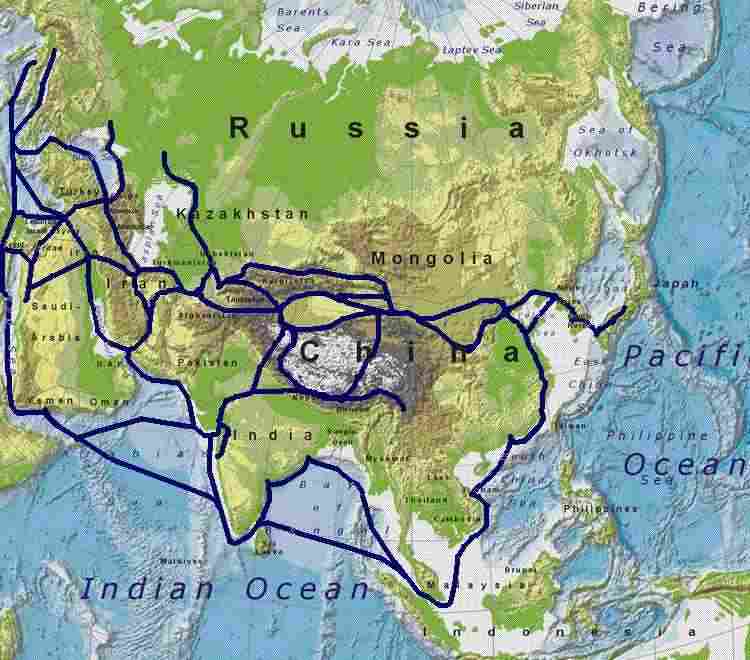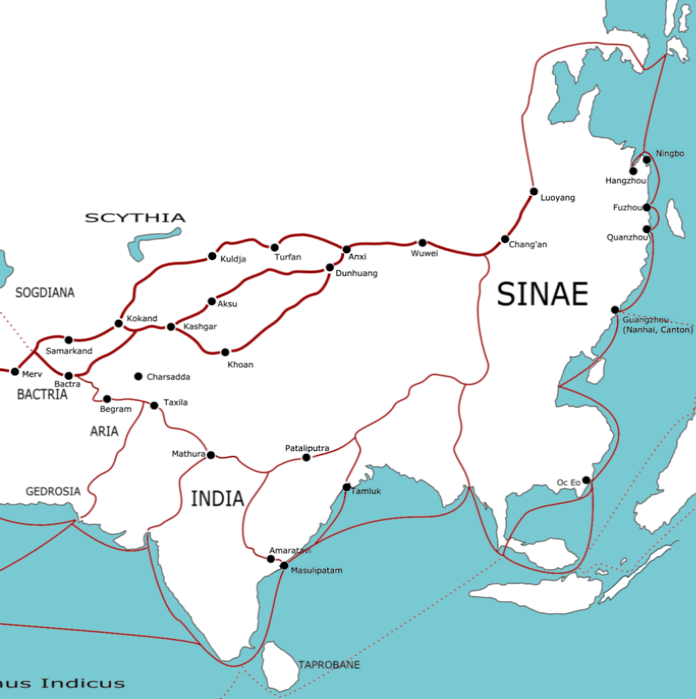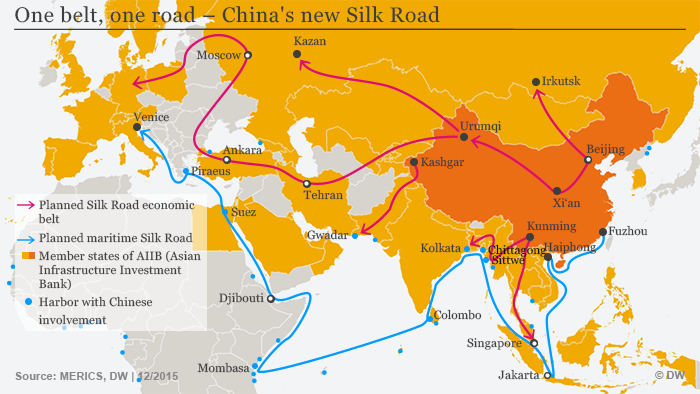It is a group of interconnected roads that convoys and ships used to pass through South Asia, linking China and Antioch in Turkey and many other regions, and also reached Japan and Korea.

The Silk Road had a great impact on the prosperity of many ancient civilizations such as Chinese, Egyptian, Indian, and Roman civilizations, even establishing the rules for the modern era. The Silk Road stretches from the commercial centers of northern China, where it is divided into two northern and southern branches. The northern branch passes from the Bulgarian-Kipchak region, through eastern Europe, the Crimea to the Black Sea, the Sea of Marmara, the Balkans, and up to Venice. As for the southern branch, it passes from Turkestan, Khurasan, and across Mesopotamia, Iraq, Anatolia, and Syria through Palmyra and Antioch to the Mediterranean, or through Damascus and the Levant to Egypt and North Africa.
Discovery of the Silk Road: The Chinese discovered the silk industry around 3000 BC, and they knew in this early time impressive art to master its craftsmanship and embroidery. This industry stunned people in the past, and they sought to acquire silk in various ways, until they were getting it for its weight in precious stones. Five thousand years ago, silk began to take its way from China to all parts of the world. Silk is not alone, of course, but many goods have escaped with it, as soon as it moved from China and the far reaches of Asia to central Asia, North Africa and Central Europe to take specific paths, known since ancient times as the Silk Road. I
n fact, the Silk Road was not a single road, but rather a network of sub roads that flow into larger or rather larger roads, one north (summer) and one winter that they used to travel in winter time. What unites all these paths and paths is that they are caravan routes from east to west, to pass on their way to countries that soon thrived with the prosperity of this most famous trade route in the ancient world.

The origins of the Silk Road:In 1877, the German geographer Ferdinand von Richhofen called the transportation route mainly for the silk trade between China in the Han dynasty and between the southern and western part of Central Asia and India as the "Silk Road". The "Silk Road" means the ancient land transportation line that extends from China and across the western and northern regions of China and Asia to all regions near Africa and Europe, and through this road, extensive exchanges were conducted in terms of politics, economy and culture between different regions and nationalities. The transfer of material civilization via the Silk Road abroad: the West began to know China from the transmission of Chinese silk via the "Silk Road" abroad.
During the Tang Dynasty, the Chinese silk industry reached a climax, and its weaving and ornamentation methods increased. In the Ming Dynasty, silk textiles inherited the many traditions of their types and vivid beauty since the Tang Dynasty, attracting merchants of different countries of the world with their excellent quality. When the silk of good quality and bright colors reached the West, admired by the highly admired Westerners, the Roman poet praised and dragged the Chinese silk as being more beautiful than flowers and more accurate than spider web.
Maritime Silk Road:The global economy has made a big shift as traders discover that sea routes are safer than land routes. This coincided with the flare-up of the Mughal-Muslim wars in the heart of Asia. Little by little, the features of the Silk Road ceased to exist and human goods and cultures moved in regular marine paths, heading across the Indian Ocean from the heat of South Asia, to North Africa, passing through the Red Sea, to receive the wild caravans from the last point in the Gulf of Suez, to transport them to boats anchored in a gap Damietta and the surrounding ports.
At this time, the rulers of the Mamluks of Egypt were charging high fees for this link, for example, they obtained black pepper and weighed gold. Mamluk Egypt flourished from time to time, until it discovered the Cape of Good Hope route, and ships became antiques in South Asia, passing through the edges of Africa, and docked on the ports of the Iberian Peninsula. Portugal and Spain prospered, and Egypt was extinguished in the late Mamluk period and during the Ottoman period. When the Suez Canal opened, and the sea route coming from Asia to Europe reached, the situation changed. Trade was organized, and the Suez Canal generated Egyptian cities from the desert. Suez and many other points were distributed along the western edge of the canal.

China's attempts to revive the Silk Road began in the early 1990s, through what was known as the Eurasian Land Bridge that connects China, Kazakhstan, Mongolia and Russia, and reaches Germany via railways.
At the end of 2013, the Chinese President Xi Jinping's Belt and Road Initiative was announced. The primary focus was on investment in infrastructure, railways and highways.
The project covers 66 countries on three continents, namely Asia, Europe and Africa, and is divided into three levels, which include focal areas, expansion areas and sub-regions.
The project includes two main branches: lands, “The Silk Road Economic Belt”, and Marine, “The Silk Road”.
The Maritime Silk Road extends from the Chinese coast through Singapore and India towards the Mediterranean, while the land branch of the initiative includes six lanes:
1- The new Eurasian land bridge that stretches from western China to western Russia.
2- China Corridor - Mongolia - Russia, which stretches from northern China to the Russian East.
3- The China-Central Asia-Western Asia Corridor, which runs from western China to Turkey.
4- China Corridor - the Indochina Peninsula that stretches from southern China to Singapore.
5- The China-Pakistan Corridor that runs from southwestern China to Pakistan.
6- The Bangladesh-China-India-Myanmar Corridor that runs from southern China to India.
Since the Chinese President launched the project, his country has invested 80 billion euros in various projects, and banks have provided loans valued between 175 and 265 billion euros.
Russia and Pakistan are the main supporters of the project, as demonstrated by the participation of Russian President Vladimir Putin and Pakistani Prime Minister Imran Khan in this summit, along with 35 heads and prime ministers from Europe, Asia, Africa and Latin America.
The project also supports Britain, Turkey and small countries such as Greece, whose foreign minister considered it the summit of economic openness at a time when many countries of the world resort to isolation themselves economically and politically.
Amidst the growing influence of China and Western doubts about its intentions, Europeans and Americans are increasingly concerned about the project, and this was evident in the limited participation of these countries in the summit that started today with the ministers, while Washington did not send anyone.
The only European exception was Italian Prime Minister Giuseppe Conte, whose country joined the Chinese initiative in March, becoming the first G7 country to make the move.
- To date, 126 countries and 29 international organizations have signed cooperation agreements with Beijing within the framework of the project, but these agreements do not provide for unconditional support for the Chinese project, but some suggest cooperation in a third country or in the field of investment.
Thanks


